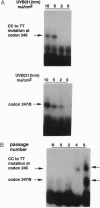Abstract
Many human skin tumors contain mutated p53 genes that probably result from UV exposure. To investigate the link between UV exposure and p53 gene mutation, we developed two methods to detect presumptive UV-specific p53 gene mutations in UV-exposed normal skin. The methods are based on mutant allele-specific PCRs and ligase chain reactions and designed to detect CC to TT mutations at codons 245 and 247/248, using 10 micrograms of DNA samples. These specific mutations in the p53 gene have been reported in skin tumors. CC to TT mutations in the p53 gene were detected in cultured human skin cells only after UV irradiation, and the mutation frequency increased with increasing UV dose. Seventeen of 23 samples of normal skin from sun-exposed sites (74%) on Australian skin cancer patients contained CC to TT mutations in one or both of codons 245 and 247/248 of the p53 gene, and only 1 of 20 samples from non-sun-exposed sites (5%) harbored the mutation. None of 15 biopsies of normal skin from non-sun-exposed or intermittently exposed sites on volunteers living in France carried such mutations. Our results suggest that specific p53 gene mutations associated with human skin cancer are induced in normal skin by solar UV radiation. Measurement of these mutations may be useful as a biologically relevant measure of UV exposure in humans and as a possible predictor of risk for skin cancer.
Full text
PDF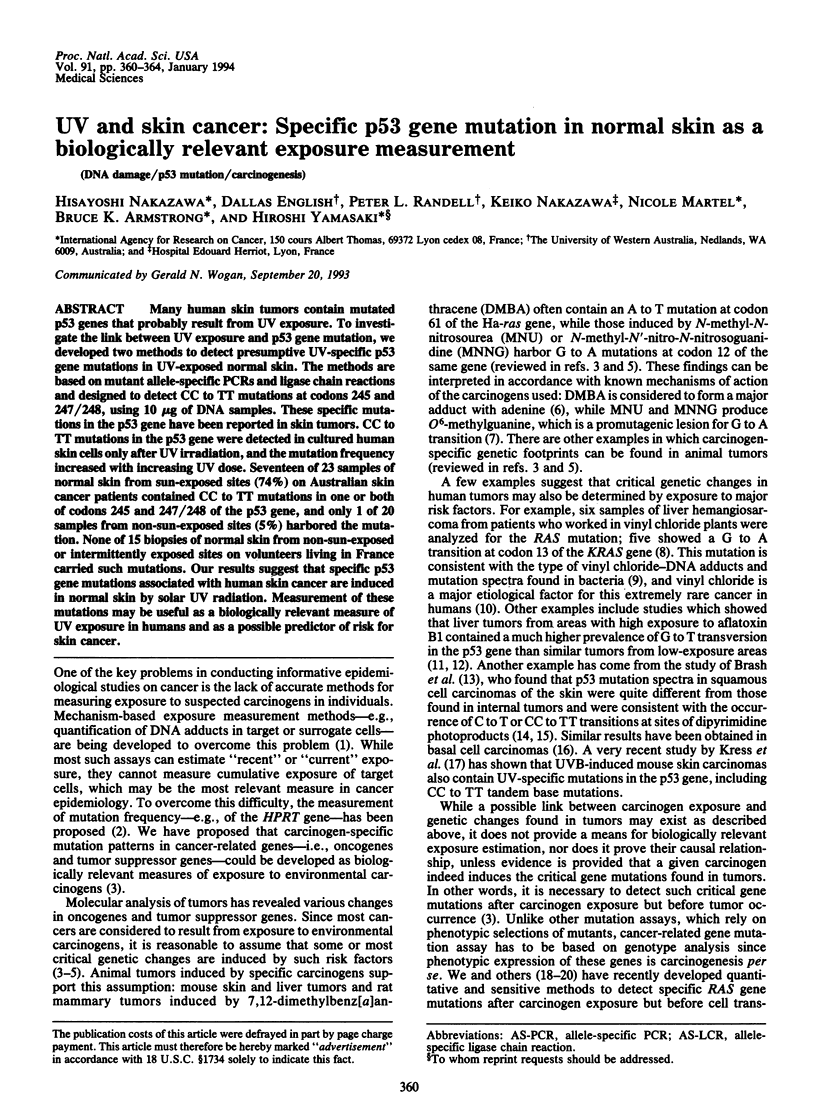
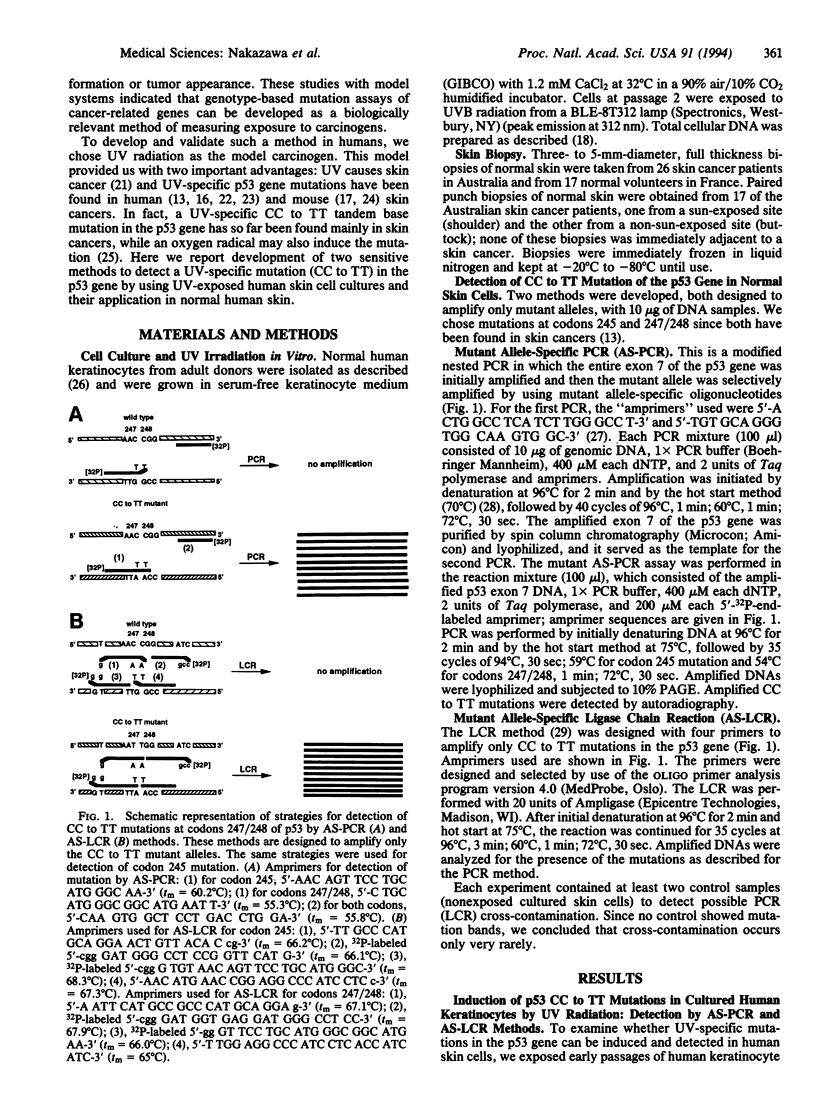
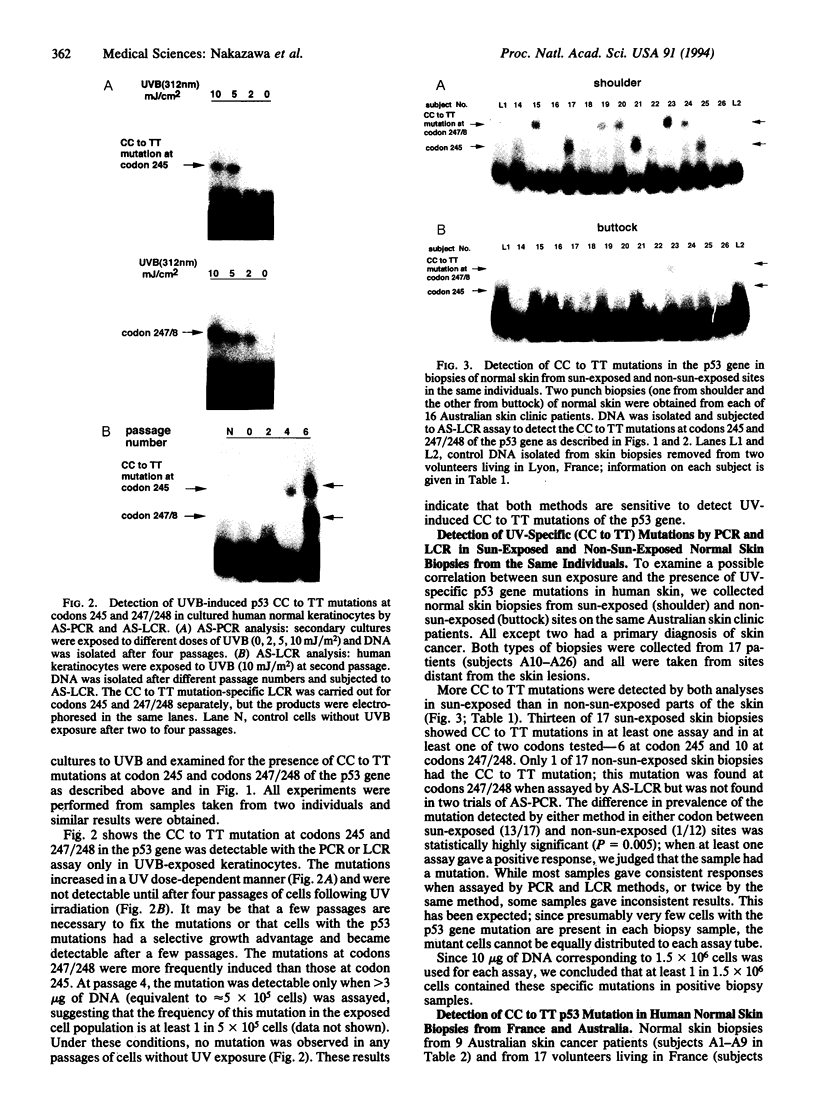
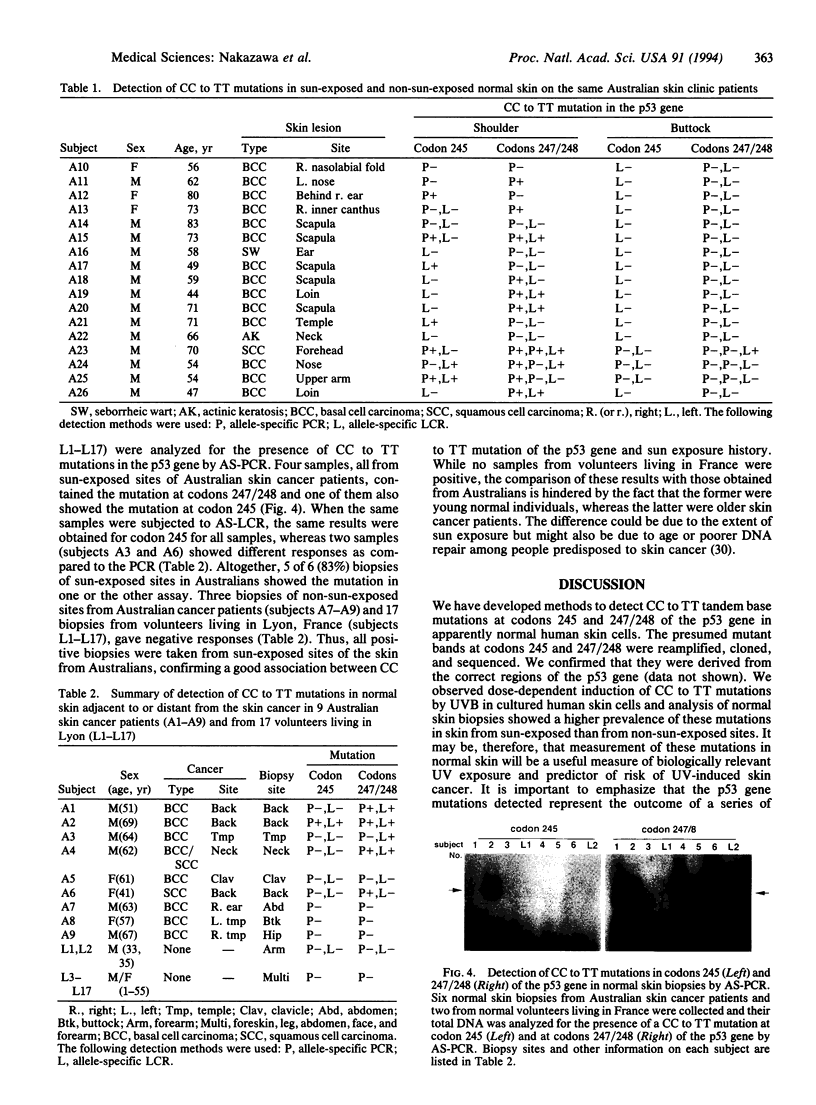
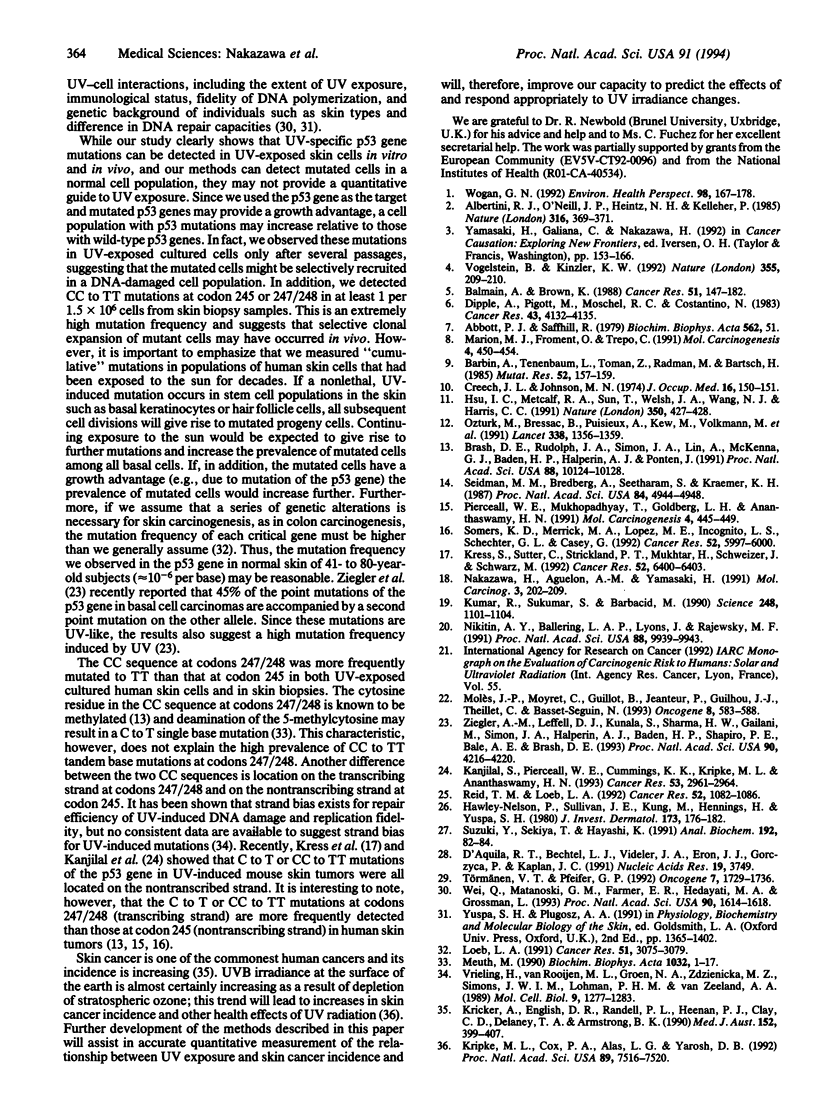
Images in this article
Selected References
These references are in PubMed. This may not be the complete list of references from this article.
- Abbott P. J., Saffhill R. DNA synthesis with methylated poly(dC-dG) templates. Evidence for a competitive nature to miscoding by O(6)-methylguanine. Biochim Biophys Acta. 1979 Mar 28;562(1):51–61. doi: 10.1016/0005-2787(79)90125-4. [DOI] [PubMed] [Google Scholar]
- Albertini R. J., O'Neill J. P., Nicklas J. A., Heintz N. H., Kelleher P. C. Alterations of the hprt gene in human in vivo-derived 6-thioguanine-resistant T lymphocytes. Nature. 1985 Jul 25;316(6026):369–371. doi: 10.1038/316369a0. [DOI] [PubMed] [Google Scholar]
- Balmain A., Brown K. Oncogene activation in chemical carcinogenesis. Adv Cancer Res. 1988;51:147–182. doi: 10.1016/s0065-230x(08)60222-5. [DOI] [PubMed] [Google Scholar]
- Barbin A., Tenenbaum L., Toman Z., Radman M., Bartsch H. recA-independent mutagenicity induced by chloroethylene oxide in E. coli. Mutat Res. 1985 Nov-Dec;152(2-3):157–159. doi: 10.1016/0027-5107(85)90057-0. [DOI] [PubMed] [Google Scholar]
- Brash D. E., Rudolph J. A., Simon J. A., Lin A., McKenna G. J., Baden H. P., Halperin A. J., Pontén J. A role for sunlight in skin cancer: UV-induced p53 mutations in squamous cell carcinoma. Proc Natl Acad Sci U S A. 1991 Nov 15;88(22):10124–10128. doi: 10.1073/pnas.88.22.10124. [DOI] [PMC free article] [PubMed] [Google Scholar]
- Creech J. L., Jr, Johnson M. N. Angiosarcoma of liver in the manufacture of polyvinyl chloride. J Occup Med. 1974 Mar;16(3):150–151. [PubMed] [Google Scholar]
- D'Aquila R. T., Bechtel L. J., Videler J. A., Eron J. J., Gorczyca P., Kaplan J. C. Maximizing sensitivity and specificity of PCR by pre-amplification heating. Nucleic Acids Res. 1991 Jul 11;19(13):3749–3749. doi: 10.1093/nar/19.13.3749. [DOI] [PMC free article] [PubMed] [Google Scholar]
- Dipple A., Pigott M., Moschel R. C., Costantino N. Evidence that binding of 7,12-dimethylbenz(a)anthracene to DNA in mouse embryo cell cultures results in extensive substitution of both adenine and guanine residues. Cancer Res. 1983 Sep;43(9):4132–4135. [PubMed] [Google Scholar]
- Hawley-Nelson P., Sullivan J. E., Kung M., Hennings H., Yuspa S. H. Optimized conditions for the growth of human epidermal cells in culture. J Invest Dermatol. 1980 Aug;75(2):176–182. doi: 10.1111/1523-1747.ep12522602. [DOI] [PubMed] [Google Scholar]
- Hsu I. C., Metcalf R. A., Sun T., Welsh J. A., Wang N. J., Harris C. C. Mutational hotspot in the p53 gene in human hepatocellular carcinomas. Nature. 1991 Apr 4;350(6317):427–428. doi: 10.1038/350427a0. [DOI] [PubMed] [Google Scholar]
- Kanjilal S., Pierceall W. E., Cummings K. K., Kripke M. L., Ananthaswamy H. N. High frequency of p53 mutations in ultraviolet radiation-induced murine skin tumors: evidence for strand bias and tumor heterogeneity. Cancer Res. 1993 Jul 1;53(13):2961–2964. [PubMed] [Google Scholar]
- Kress S., Sutter C., Strickland P. T., Mukhtar H., Schweizer J., Schwarz M. Carcinogen-specific mutational pattern in the p53 gene in ultraviolet B radiation-induced squamous cell carcinomas of mouse skin. Cancer Res. 1992 Nov 15;52(22):6400–6403. [PubMed] [Google Scholar]
- Kricker A., English D. R., Randell P. L., Heenan P. J., Clay C. D., Delaney T. A., Armstrong B. K. Skin cancer in Geraldton, Western Australia: a survey of incidence and prevalence. Med J Aust. 1990 Apr 16;152(8):399–407. doi: 10.5694/j.1326-5377.1990.tb125266.x. [DOI] [PubMed] [Google Scholar]
- Kripke M. L., Cox P. A., Alas L. G., Yarosh D. B. Pyrimidine dimers in DNA initiate systemic immunosuppression in UV-irradiated mice. Proc Natl Acad Sci U S A. 1992 Aug 15;89(16):7516–7520. doi: 10.1073/pnas.89.16.7516. [DOI] [PMC free article] [PubMed] [Google Scholar]
- Kumar R., Sukumar S., Barbacid M. Activation of ras oncogenes preceding the onset of neoplasia. Science. 1990 Jun 1;248(4959):1101–1104. doi: 10.1126/science.2188364. [DOI] [PubMed] [Google Scholar]
- Loeb L. A. Mutator phenotype may be required for multistage carcinogenesis. Cancer Res. 1991 Jun 15;51(12):3075–3079. [PubMed] [Google Scholar]
- Marion M. J., Froment O., Trépo C. Activation of Ki-ras gene by point mutation in human liver angiosarcoma associated with vinyl chloride exposure. Mol Carcinog. 1991;4(6):450–454. doi: 10.1002/mc.2940040607. [DOI] [PubMed] [Google Scholar]
- Meuth M. The structure of mutation in mammalian cells. Biochim Biophys Acta. 1990 Jun 1;1032(1):1–17. doi: 10.1016/0304-419x(90)90009-p. [DOI] [PubMed] [Google Scholar]
- Molès J. P., Moyret C., Guillot B., Jeanteur P., Guilhou J. J., Theillet C., Basset-Sèguin N. p53 gene mutations in human epithelial skin cancers. Oncogene. 1993 Mar;8(3):583–588. [PubMed] [Google Scholar]
- Nakazawa H., Aguelon A. M., Yamasaki H. Relationship between chemically induced Ha-ras mutation and transformation of BALB/c 3T3 cells: evidence for chemical-specific activation and cell type-specific recruitment of oncogene in transformation. Mol Carcinog. 1990;3(4):202–209. doi: 10.1002/mc.2940030407. [DOI] [PubMed] [Google Scholar]
- Nikitin AYu, Ballering L. A., Lyons J., Rajewsky M. F. Early mutation of the neu (erbB-2) gene during ethylnitrosourea-induced oncogenesis in the rat Schwann cell lineage. Proc Natl Acad Sci U S A. 1991 Nov 15;88(22):9939–9943. doi: 10.1073/pnas.88.22.9939. [DOI] [PMC free article] [PubMed] [Google Scholar]
- Ozturk M. p53 mutation in hepatocellular carcinoma after aflatoxin exposure. Lancet. 1991 Nov 30;338(8779):1356–1359. doi: 10.1016/0140-6736(91)92236-u. [DOI] [PubMed] [Google Scholar]
- Pierceall W. E., Mukhopadhyay T., Goldberg L. H., Ananthaswamy H. N. Mutations in the p53 tumor suppressor gene in human cutaneous squamous cell carcinomas. Mol Carcinog. 1991;4(6):445–449. doi: 10.1002/mc.2940040606. [DOI] [PubMed] [Google Scholar]
- Reid T. M., Loeb L. A. Mutagenic specificity of oxygen radicals produced by human leukemia cells. Cancer Res. 1992 Mar 1;52(5):1082–1086. [PubMed] [Google Scholar]
- Seidman M. M., Bredberg A., Seetharam S., Kraemer K. H. Multiple point mutations in a shuttle vector propagated in human cells: evidence for an error-prone DNA polymerase activity. Proc Natl Acad Sci U S A. 1987 Jul;84(14):4944–4948. doi: 10.1073/pnas.84.14.4944. [DOI] [PMC free article] [PubMed] [Google Scholar]
- Somers K. D., Merrick M. A., Lopez M. E., Incognito L. S., Schechter G. L., Casey G. Frequent p53 mutations in head and neck cancer. Cancer Res. 1992 Nov 1;52(21):5997–6000. [PubMed] [Google Scholar]
- Suzuki Y., Sekiya T., Hayashi K. Allele-specific polymerase chain reaction: a method for amplification and sequence determination of a single component among a mixture of sequence variants. Anal Biochem. 1991 Jan;192(1):82–84. doi: 10.1016/0003-2697(91)90188-y. [DOI] [PubMed] [Google Scholar]
- Törmänen V. T., Pfeifer G. P. Mapping of UV photoproducts within ras proto-oncogenes in UV-irradiated cells: correlation with mutations in human skin cancer. Oncogene. 1992 Sep;7(9):1729–1736. [PubMed] [Google Scholar]
- Vogelstein B., Kinzler K. W. Carcinogens leave fingerprints. Nature. 1992 Jan 16;355(6357):209–210. doi: 10.1038/355209a0. [DOI] [PubMed] [Google Scholar]
- Vrieling H., Van Rooijen M. L., Groen N. A., Zdzienicka M. Z., Simons J. W., Lohman P. H., van Zeeland A. A. DNA strand specificity for UV-induced mutations in mammalian cells. Mol Cell Biol. 1989 Mar;9(3):1277–1283. doi: 10.1128/mcb.9.3.1277. [DOI] [PMC free article] [PubMed] [Google Scholar]
- Wei Q., Matanoski G. M., Farmer E. R., Hedayati M. A., Grossman L. DNA repair and aging in basal cell carcinoma: a molecular epidemiology study. Proc Natl Acad Sci U S A. 1993 Feb 15;90(4):1614–1618. doi: 10.1073/pnas.90.4.1614. [DOI] [PMC free article] [PubMed] [Google Scholar]
- Wogan G. N. Molecular epidemiology in cancer risk assessment and prevention: recent progress and avenues for future research. Environ Health Perspect. 1992 Nov;98:167–178. doi: 10.1289/ehp.9298167. [DOI] [PMC free article] [PubMed] [Google Scholar]
- Ziegler A., Leffell D. J., Kunala S., Sharma H. W., Gailani M., Simon J. A., Halperin A. J., Baden H. P., Shapiro P. E., Bale A. E. Mutation hotspots due to sunlight in the p53 gene of nonmelanoma skin cancers. Proc Natl Acad Sci U S A. 1993 May 1;90(9):4216–4220. doi: 10.1073/pnas.90.9.4216. [DOI] [PMC free article] [PubMed] [Google Scholar]



